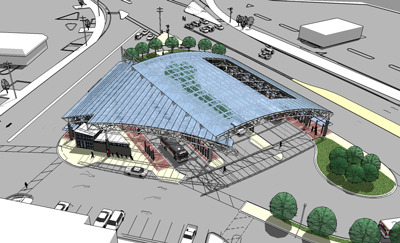Several transportation agencies in the Washington region are using grant funding awarded under the federal TIGER program to make bus transit a more reliable and convenient travel option for area residents.
The 16 projects funded under the grant are located mainly along key transportation corridors connecting residential, commercial, and employment centers. The projects all aim to improve the quality of bus service through such improvements as new lanes and priority signals that allow buses to bypass auto traffic and move more quickly through intersections, real-time arrival information displays, and new and upgraded bus stops and stations.
The TPB applied for the funding for the projects in 2009, the first year of the U.S. Department of Transportation’s Transportation Investment Generating Economic Recovery program, or TIGER. The competitive grant program was one of many funded by the American Recovery and Reinvestment Act of 2009 aimed at stimulating the economy and creating jobs.
The TPB received a total of $58.8 million for the projects and in 2011 started distributing the funds to the transportation agencies responsible for implementing them -- the Maryland and District departments of transportation, the Washington Metropolitan Area Transit Authority (WMATA), the Potomac and Rappahannock Transportation Commission (PRTC), and the City of Alexandria.
Several of the projects have been partially or fully implemented. The one project closest to full implementation is the purchase of 13 new clean-emissions commuter buses that PRTC will operate between Prince William County and job centers in Northern Virginia and the District of Columbia.
Some of the other projects that are already underway aim to prevent delays by taking buses out of regular traffic and putting them into dedicated lanes for all or part of their routes.
The Crystal City-Potomac Yard Transitway, which the City of Alexandria is implementing and which is due to open in 2014, will include a five-mile priority corridor along U.S. Route 1, a 0.8-mile stretch of which will be a dedicated bus-only lane paid for by the TIGER grant.
The District of Columbia will also soon install a dedicated bus-only lane on Georgia Avenue NW near Howard University, as well as "queue jump lanes"on 16th Street NW which will allow buses to bypass automobile traffic at intersections.
The City of Alexandria will also install queue jump lanes between the Van Dorn and Pentagon Metrorail stations.
The TIGER grant is also helping pay for a number of transit signal priority efforts, which aim to adjust the pattern of traffic lights to make sure that buses can pass through intersections with minimal delays. These efforts are underway on Wisconsin Avenue in the District, University Boulevard in Maryland, and along Leesburg Pike in Virginia.

Takoma/Langley Transit Center rendering by ArchPlan, Inc. for the Maryland Department of Transportation.
|
Finally, more than $20 million in funding under the TIGER grant is being spent on building new and improved bus stations -- one in Maryland and two in Virginia.
In Maryland, the state department of transportation will use $11.8 million in grant funding to construct a new bus station at the intersection of New Hampshire Avenue and University Boulevard near the border of Prince George's and Montgomery Counties in Maryland.
The new station will consolidate several existing bus stops in the Takoma/Langley Crossroads area -- already a busy bus corridor -- and provide shelter and install new crosswalks and signals to make pedestrian access to the station safer and easier. The transit center will also be a station on the planned Purple Line.
In Virginia, WMATA is carrying out improvements to major bus stations at the Franconia-Springfield and Pentagon Metrorail stations. The transit agency is using $9.4 million from the TIGER grant to build new bus bays to increase bus capacity and decrease turn-around times, and to install real-time information displays to provide anticipated bus arrival times and notices of delay. The funding will also help reconfigure roadways in the station areas to improve the flow of through-traffic and make drop-offs more convenient.
Federal TIGER grants are awarded through a nationwide competitive selection process. In 2009, USDOT received more than 1,400 applications for well over $60 billion in funding, ultimately awarding $1.5 billion in funding to 51 projects.
As the applicant for the TIGER funds now being used to make bus transit in the Washington region more convenient and reliable, the TPB was able to bring together several of the region's transportation agencies, not only for the TIGER grant, but also to start thinking differently about how individual bus systems connect with and support one another and the region's transit network.
Related Links